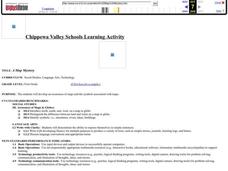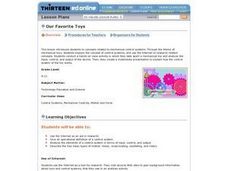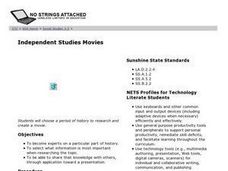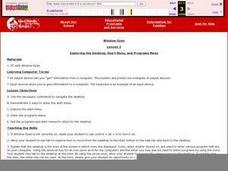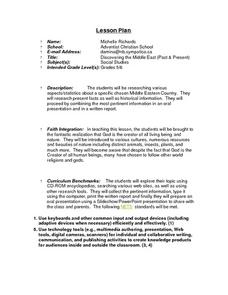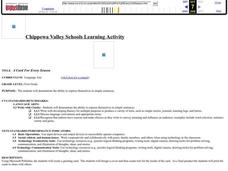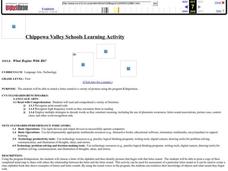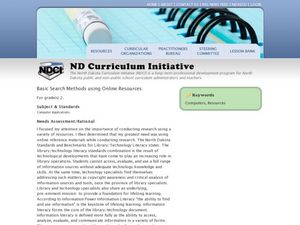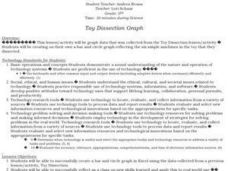Curated OER
Input Devices
Eleventh graders recall and identify what terms mean. They give an example of one of the term's hardware components. Students are taught how Input and Output devices work. They recognize acutual component in the computer as they are...
Curated OER
Computers: Inside & Out-Outer Hardware Input/Output Worksheet
In this computer hardware instructional activity, learners read a brief paragraph about the differences between computer output and input devices, then write input or output next to a list of 11 computer components.
Curated OER
6.1 Computing Components
Students define computer terms such as hardware, software, input and output devices, central processing unit, etc. in their own words, and relate terms to computer system they are using.
Teach Engineering
Efficiency of a Water Heating System
Tired of waiting for hot water? Groups of three determine the efficiency of an electric water-heating device. They calculate the amount of energy it takes to heat the water and the theoretical amount of energy required to heat the water....
Texas State Energy Conservation Office
Power Systems & Efficiency
Are you looking for a reading resource about the efficiency of power systems? Here is one that introduces the output/input ratio, measurement of energy by joules or calories, and efficiency ratings. For STEM classes that are learning...
Curated OER
A Map Mystery
First graders solve a mystery by following map clues. In this map clues lesson plan, 1st graders follow a computer program called Neighborhood Map Machine. In this program, it gives students directional and spatial clues in order to...
Curated OER
Our Favorite Toys
Pupils give an operational definition of a control system. They analyze the elements of a control system in terms of input, control, and output and describe the four basic types of motion: linear, reciprocating, oscillating, and rotary.
Curated OER
FCAT...It's a Jungle Out There!
Fourth graders use a digital camera to take pictures of other students demonstrating good FCAT test-taking tips. They compile the pictures into a movie and add text and voiceovers to describe the test-taking tips.
Curated OER
Independent Studies Movies
History comes alive as groups work cooperatively to create short iMovies about a specific historical period of their choice. Ideal for late elementary grades, the lesson includes a video demonstration and a short materials list.
Curated OER
My Name Is...
First graders write four simple sentences about themselves. In this simple sentences lesson plan, learners insert a picture of themselves into Microsoft Word. Everyone writes four simple sentences about themselves. These pictures and...
Curated OER
M & M Madness
M&M's are always a great manipulative to use when teaching math. In this graphing lesson plan, learners predict how many of each color of M & M's there are. They count up each color and plug the data into a graph using the...
Curated OER
Exploring the Desktop, Start Menu, And Programs Menu
Learners study commands to navigate the desktop, enter the start menu, and enter and exit the programs menu.
Curated OER
Who is Rube Goldberg?
Fifth graders practice technology skills while searching online for information about inventor, Rube Goldberg. They discuss Rube Goldberg's use of simple machines, and write journal entries about their findings.
Curated OER
Discovering the Middle East (Past & Present)
Students, after being assigned a specific Middle Eastern Country, research various aspects/statistics as well as historical information on their country. They combine their acquired information in an oral presentation and written report....
Curated OER
Minnesota Birds
Students, while assessing bird stories in the Bible, discuss and work on activities where they compare/contrast birds to people. They view how they are unique and special to God. In addition, they create a slide show of bird photographs...
Curated OER
How Computers Work Scavenger Hunt
In this computers activity, learners utilize the Internet to access one specific website to solve the answers to five short answer questions involving how computers work.
Curated OER
A Card For Every Season
First graders express themselves in simple sentences through the use of computer generated greeting cards. For this greeting card lesson, 1st graders use Microsoft Publisher to design a cover and create text for the inside of a greeting...
Curated OER
What Begins With Bb?
First graders match letter sounds to pictures they represent. In this matching letter sound lesson plan, 1st graders use the computer program Kidspiration to match the letter sounds to the corresponding pictures. This can be used for 1...
Curated OER
Name That Sound
First graders match different pictures to the correct beginning and ending sounds they go with. In this sound lesson plan, 1st graders will use the computer program Kid Pix to go through a variety of pictures. They then match the picture...
Curated OER
Gummy Bear Math
First graders predict, collect data, and create a graph based on gummy bear colors they are given. In this graphing lesson plan, 1st graders first predict how many colors of gummy bears there are. They then count the colors, graph them,...
Curated OER
Basic Search Methods Using Online Resources
Second graders practice using technology to gather information. In this online research lesson, 2nd graders use technology to find information for a research project. Students write a research paper, and give a presentation to the class...
Curated OER
Digital Logic Signals
In this electronics activity, students interpret schematic diagrams and analyze circuit components to answer 9 short answer and problem solving questions.
Curated OER
PowerPoint Presentation
Students work together to research different aspects about the country of Japan and its culture. Using PowerPoint, they organize their information to be shared with their classmates. They are asked questions by their teacher to end their...
Curated OER
Toy Dissection Graph
Students explore simple machines and how they are made. They examine the parts of the simple machine and collect information about its parts. Using Excel, students create circle and bar graphs from the collected data.





